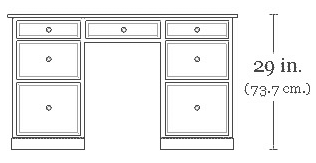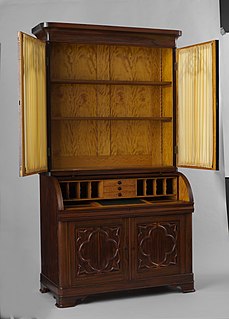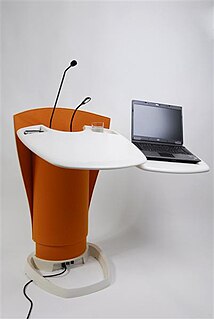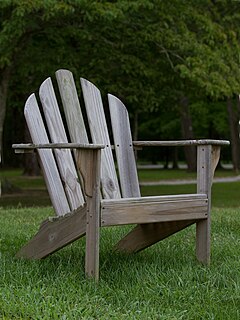
Furniture refers to movable objects intended to support various human activities such as seating, eating (tables), storing items, eating and/or working with an item, and sleeping. Furniture is also used to hold objects at a convenient height for work, or to store things. Furniture can be a product of design and can be considered a form of decorative art. In addition to furniture's functional role, it can serve a symbolic or religious purpose. It can be made from a vast multitude of materials, including metal, plastic, and wood. Furniture can be made using a variety of woodworking joints which often reflects the local culture.

A desk or bureau is a piece of furniture with a flat table-style work surface used in a school, office, home or the like for academic, professional or domestic activities such as reading, writing, or using equipment such as a computer. Desks often have one or more drawers, compartments, or pigeonholes to store items such as office supplies and papers. Desks are usually made of wood or metal, although materials such as glass are sometimes seen.

A pedestal desk or a tanker desk is usually a large, flat, free-standing desk made of a simple rectangular working surface resting on two pedestals or small cabinets of stacked drawers of one or two sizes, with plinths around the bases. Often, there is also a central large drawer above the legs and knees of the user. Sometimes, especially in the 19th century and modern examples, a "modesty panel" is placed in front, between the pedestals, to hide the legs and knees of the user from anyone else sitting or standing in front. This variation is sometimes called a "panel desk". The smaller and older pedestal desks with such a panel are sometimes called kneehole desks, and were usually placed against a wall.

A secretary desk or escritoire is made of a base of wide drawers topped by a desk with a hinged desktop surface, which is in turn topped by a bookcase usually closed with a pair of doors, often made of glass. The whole is usually a single, tall and heavy piece of furniture.
The portable desk had many forms and is an ancestor of the portable computer, the modern laptop an atavistic grandchild of the 19th-century lap desk.

The fall front desk can be considered the cousin of the secretary desk. Both have a main working surface or desktop which does double duty as a cover to seal up papers and other items located in small shelves or small drawers placed one on top of the other in front of the user. Thus, all working papers, documents and other items have to be stored before the desk is closed.

The slant top desk, also called secretary desk, or more properly, a bureau is a piece of writing furniture with a lid, when closed stays at an angle, and opens up as a writing surface. It can also be considered related, in form, of the desk on a frame, which was a form of portable desk in earlier eras.

The lectern desk exists in two distinct forms, antique and modern.

A Bible box is a small container that is used to store a bible. About the size of a bible, this box could be used to transport in safety what was a very costly book. Many varieties had a slanted or angled top with a lower lip, meant to hold the Bible for reading when the box was placed on a table. In a sense it then served as a portable lectern. Over the years the typical Bible box was also used or specifically built to contain writing implements such as a quill, ink pot, blotting paper and writing paper. The level or slanted surface of the box then served as a desktop for writing as well as reading.

In cabinetry, the bargueño is a form of portable desk, made up of two chests, the bottom one usually having drawers and the top one having a hinged desk surface which also serves as a side-mounted lid. It is basically a chest or box with one of the side panels, rather than the top panel, serving as a fold-out writing surface. The interior of the desk is equipped with small drawers, pigeonholes, etc., for storing papers and supplies. The bargueño has also been used for sewing or as a jewel chest.
A Plantation desk is an antique desk form. It is thought to have been originally used as a mail desk by postmen. The form is known to have been used on Southern plantations in the United States, but it is not limited to them. For some time communities of Shakers in New England built a large version of this form of desk. It was quite popular in the 19th century.

A chest is a form of furniture typically of a rectangular structure with four walls and a removable or hinged lid, used for storage, usually of personal items. The interior space may be subdivided.

Wicker is the oldest furniture making method known to history, dating as far back as 5,000 years ago. It was first documented in ancient Egypt using pliable plant material, but in modern times it is made from any pliable, easily woven material. The word wicker or "wisker" is believed to be of Scandinavian origin: vika, which means "to fold" in Swedish, and vikker meaning willow. Wicker is traditionally made of material of plant origin, such as willow, rattan, reed, and bamboo, but synthetic fibers are now also used. Wicker is light yet sturdy, making it suitable for items that will be moved often like porch and patio furniture. Rushwork and wickerwork are terms used in England. A typical braiding pattern is called Wiener Geflecht, Viennese Braiding, as it was invented in 18th century Vienna and later most prominently used with the Thonet coffeehouse chair.

A lectern is a reading desk with a slanted top, on which documents or books are placed as support for reading aloud, as in a scripture reading, lecture, or sermon. A lectern is usually attached to a stand or affixed to some other form of support. To facilitate eye contact and improve posture when facing an audience, lecterns may have adjustable height and slant. People reading from a lectern, called lectors, generally do so while standing.

A folding chair is a type of folding furniture, a light, portable chair that folds flat or to a smaller size, and can be stored in a stack, in a row, or on a cart.

The forms of Chinese furniture evolved along three distinct lineages which dates back to 1000 BC, based on frame and panel, yoke and rack and bamboo construction techniques. Chinese home furniture evolved independently of Western furniture into many similar forms including chairs, tables, stools, cupboards, cabinets, beds and sofas. Until about the 10th century CE the Chinese sat on mats or low platforms using low tables, in typical Asian style, but then gradually moved to using high tables with chairs.

Rustic furniture is furniture employing sticks, twigs or logs for a natural look. The term “rustic” is derived from Latin “rusticus”. The style is rooted in Romantic tradition. In the US it is almost synonymous with the National Park Service rustic style of architecture. Many companies, artists and craftspeople make rustic furniture in a variety of styles and with a variety of historical and contemporary influences.

A cabinet is a case or cupboard with shelves and/or drawers for storing or displaying items. Some cabinets are stand alone while others are built in to a wall or are attached to it like a medicine cabinet. Cabinets are typically made of wood, coated steel, or synthetic materials. Commercial grade cabinets usually have a melamine-particleboard substrate and are covered in a high pressure decorative laminate, commonly referred to as Wilsonart or Formica.

Louis XIV furniture was massive and lavishly covered with sculpture and ornament of gilded bronze in the earlier part of the personal rule of King Louis XIV of France (1660–1690). After about 1690, thanks in large part to the furniture designer André Charles Boulle, a more original and delicate style appeared, sometimes known as Boulle Work. It was based on the use of marquetry, the inlay of piece of ebony and other rare woods, a technique first used in Florence in the 15th century, which was refined and developed by Boulle and others working for the King. Furniture was inlaid with thin plaques of ebony, copper, mother of pearl, and exotic woods of different colors in elaborate designs.

















